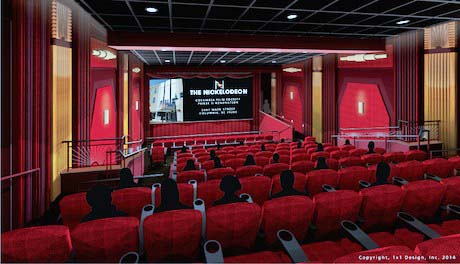Nickelodeon begins renovation of second theater

From The Free Times:
The Nickelodeon, which moved to its new home on Main Street in 2012, is forging ahead with construction of an upstairs screening space, scheduled to be completed by spring 2015.With 125 seats, the upstairs theater will be both larger and more upscale than the current screening space downstairs, which has 100 seats.The seats will also be nicer and more comfortable, says Executive Director Andy Smith, and plans call for restoring all the Art Deco flourishes from the refurbished theater’s Depression-era heritage.The theater will be equipped with projection systems that will accommodate both digital and 35 mm formats.After completing the $3 million Phase 1 construction of the Main Street theater in 2012, The Nick started raising $2 million for Phase 2, which covers the upstairs screening space.This final phase is still just shy of raising $180,000, which is needed both to cover construction costs and to establish a facility reserve fund.The facility reserve fund is both a rainy day account to cover emergencies and to prepare for any expensive format changes to film projection standards that may be on the horizon.The Nickelodeon is hoping to raise the $180,000 remainder through the Save Your Seat campaign, wherein donors can buy a seat at the new theater for $1,500.For Smith, having two screens not only doubles viewer choices but reduces programming conflicts. The Nickelodeon would not have to choose between indie films that open on the same weekend, as was the case this past summer with Boyhood and Magic in the Moonlight.
Also, having two screens keeps the theater from being tied up with a single movie for an extended period.
“If we’re showing Birdman for two weeks, we’ll have the opportunity to bring in some of the smaller films that, when you only have one screen, are tougher to program,” Smith says.
Another consideration is The Nick’s core audience, some of whom were there from the beginning in 1979, and never missed a show at the old Pendleton and Main location.
“We have audiences, especially from the old space, that are used to coming to us every week to see what we were showing. If we show the same film for four weeks in a row, we don’t see them three other times during the month. That’s what’s so exciting to us, is that it allows us to bring more to our potential customers.”
Also, it allows for more risk, which has always been a Nickelodeon trademark.
“When you’re only one screen, your revenue for the night is 100 percent dependent on what you’re showing,” Smith says. “If you’re showing something kind of obscure, and you only have six people come, that’s kind of expensive.”
Having one screen showing a well-known or popular film shoulders the financial burden of a lesser-known foreign import or documentary.
“What multiplexes figured out a long time ago is the more screens you have, the better chance you have that you’re showing something that someone wants to see,” Smith says. “And your overhead doesn’t really go up when you add a screen. You’re still selling tickets and concessions at the same place.”
On average, Smith says, theaters across the country have seen a 110 percent increase in ticket sales by adding a second screen.
“Your audience more than doubles, and that’s going to have a real impact on us and really let us grow.”
Smith expects the added revenue will also help support the theater’s Helen Hills Media Education Center, which teaches filmmaking and cinema appreciation to students, as well as the annual Indie Grits Festival.
The construction plans will put staff offices upstairs, freeing downstairs space for the Media Education Lab for afterschool and summer camp programs.
Smith says keeping a 35 mm projection system is important to show films that are not available digitally. That would include the bulk of material stored at the University of South Carolina’s Moving Image Research Collections, which uses the Nickelodeon for its annual Home Movie Day and other events.
Once construction is complete next year, Smith says the Nick’s immediate focus will be on the film program.
“Our big goals are going to be to grow the education programs a lot,” he says.
Besides the annual Indie Grits Festival — which has become an annual institution for new and struggling filmmakers around the South — the Nick is expanding its focus both high (New York Film Critics Series) and low (First Friday Lowbrow Cinema Explosion).
“We want to foster the artistic community here in Columbia,” Smith says. “We’ve still got work to do, but I think we’re really making strides.”
Image: rendering of the upstairs second screen

